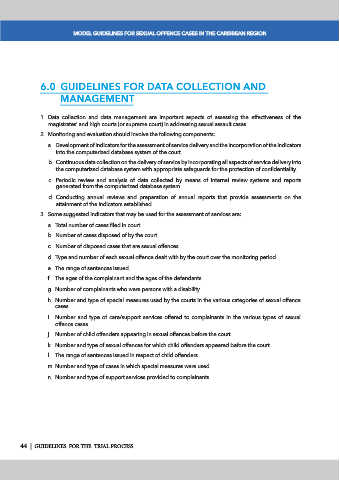Page 643 - Magistrates Conference 2019
P. 643
MODEL GUIDELINES FOR SEXUAL OFFENCE CASES IN THE CARIBBEAN REGION
6.0 GUIDELINES FOR DATA COLLECTION AND
MANAGEMENT
1. Data collection and data management are important aspects of assessing the effectiveness of the
magistrates’ and high courts (or supreme court) in addressing sexual assault cases.
2. Monitoring and evaluation should involve the following components:
a. Development of indicators for the assessment of service delivery and the incorporation of the indicators
into the computerized database system of the court.
b. Continuous data collection on the delivery of service by incorporating all aspects of service delivery into
the computerized database system with appropriate safeguards for the protection of confidentiality.
c. Periodic review and analysis of data collected by means of internal review systems and reports
generated from the computerized database system.
d. Conducting annual reviews and preparation of annual reports that provide assessments on the
attainment of the indicators established.
3. Some suggested indicators that may be used for the assessment of services are:
a. Total number of cases filed in court.
b. Number of cases disposed of by the court.
c. Number of disposed cases that are sexual offences.
d. Type and number of each sexual offence dealt with by the court over the monitoring period.
e. The range of sentences issued.
f. The ages of the complainant and the ages of the defendants.
g. Number of complainants who were persons with a disability.
h. Number and type of special measures used by the courts in the various categories of sexual offence
cases.
i. Number and type of care/support services offered to complainants in the various types of sexual
offence cases.
j. Number of child offenders appearing in sexual offences before the court.
k. Number and type of sexual offences for which child offenders appeared before the court.
l. The range of sentences issued in respect of child offenders.
m. Number and type of cases in which special measures were used.
n. Number and type of support services provided to complainants.
44 | GUIDELINES FOR THE TRIAL PROCESS

